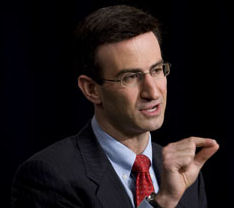by James A. Bacon
Peter Orszag, President Obama’s former Office of Management and Budget (OMB) chief, has finally come around to my way of thinking. His new thesis, explicated on Bloomberg.com, is almost identical to one of the core arguments I made in Boomergeddon, to wit, that the economy has entered a business cycle marked by tepid economic growth and that an anemic expansion will push budget deficits higher than forecast over the next several years.
Too bad he didn’t think that way back when he was running OMB and had some influence over President Obama, the stimulus package and health care reform. Oh, well. Better late than never.
Pardon me while I gloat. After all, gloating is really all I have. I’m not influencing national policy like Orszag did, nor am I making zillions of dollars on Wall Street, like Orszag, now vice chairman of global banking at Citigroup, is now doing. I have to take my pleasures where I can find them.
In Boomergeddon, I critiqued the economic-growth assumptions embedded in the 10-year budget forecast that accompanied Obama’s proposed FY 2011 budget. I compared the projected growth rate of the United States economy, prepared by Orszag’s team, with that of previous business cycles under Reagan, Clinton and Bush. The Obama forecast assumed a business cycle that would almost equal those of the super-heated Reagan/Bush I and Clinton, Internet-era expansions. While most mainstream economists found that to be perfectly plausible at the time, I did not.
It was clear to me that the collapse of the real estate boom marked the end of massive consumer borrowing — the end of the era of mass overconsumption, to use a phrase bandied about this blog. Consumer spending, which had fueled the previous three economic expansions, would be a drag. It was equally clear that there was a massive overhang of bad debt in the real estate markets, both residential and commercial. Those critical sectors also would be laggards. I also foresaw that state/local government spending would remain depressed for longer than normal during the business cycle, and I predicted that inflation in commodity prices (energy, raw materials, food) would exercise a dampening effect on expansion earlier in the business cycle than in the past. Finally, as any doofus could have foretold, federal fiscal and monetary stimulus would have to end, and when it did, the economy would lose even more momentum.
That doesn’t sound especially prescient today — those are basically the factors that anyone would cite to explain the economy’s lackluster growth. Trouble is, back when I was writing Boomergeddon a year to a year-and-a-half ago, only a handful of gold bugs and other gloom mongers were paying attention to those indicators. Looking toward the longer term, I noted that slower population growth, the steady drift of corporate America toward rent-seeking behavior (competing in the political sphere by seeking subsidies, loan guarantees and favorable regulations instead of through market innovation), the uncertainties created by massive government indebtedness and turmoil in European sovereign bond markets also would depress growth.
What I underestimated, although I did allude to it, was the negative impact of Obama economic policies. For the most part, however, I left Obama’s policies out of the equation because I knew that advancing that argument would ignite the partisan passions of those who would defend the president to the death. It was enough to know, I said, that economic growth would remain depressed no matter who was in charge, and no matter what economic policies they pursued.
So, how did my analysis play out? Listen to Orszag: “If we are in for sluggish growth over the next few years, the labor market won’t be the only aspect of the economy that does worse than official projections; the budget deficit will be significantly bigger as well.” He continues:
The CBO paints a surprisingly auspicious picture of the fiscal shortfall, averaging 3.4 percent of gross domestic product over the next decade and dipping to about 3 percent by 2020. … [The Center for Budgetary and Policy Priorities] predicts a more realistic deficit for the next 10 years of 5.7 percent of GDP under current policies, and hovering around 6 percent toward the end of the decade. The dollar amount of the cumulative deficit over the next decade is projected to exceed $11 trillion.
But the actual picture could be even worse. Just as I asked Chmura Economics & Analytics, a Richmond-based consulting firm, to calculate the fiscal impact of slow economic growth and a late-2010s recession on the budget, Orszag asked Richard Kogan with the CBPP to run a similar exercise.
The CBO assumes economic growth will exceed 3 percent per year from 2012 to 2016 before gradually declining to a bit more than 2 percent in 2021. What if, instead, growth remains at 2 percent to 2.5 percent for the next decade? I asked Kogan to recalculate the budget numbers assuming a constant growth rate of 2.25 percent per year, which seems a plausible hard-slog scenario.
He found that the deficit then averages more than 7 percent of GDP. By 2021, it is more than 8.5 percent of GDP and increasing.
There you have it. All Orszag’s analysis now lacks is an understanding of what happens when interest rates start pushing higher than he was predicting a year and a half ago. That’s when the deficit really goes through the roof. All things considered, the economic thesis of Boomergeddon is holding up remarkably well. If you want to understand the economic dynamics driving the budget crisis today, try reading the analysis of someone (me) who saw what was coming. Order Boomergeddon today. It is incisive yet written in language that any well-read layman can understand.



